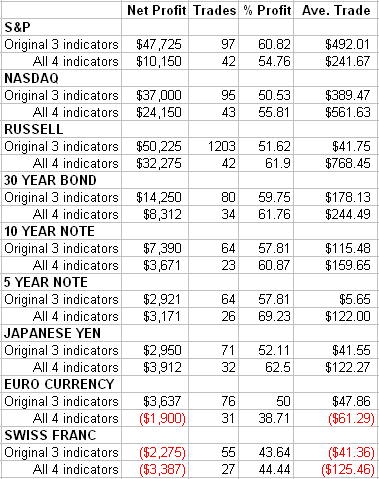As we've seen in the last few postings, going in the direction of a majority of basic indicators produces a fairly robust result. A logical question might then be, what about taking a position only when all the indicators line up in the same direction? Could we expect to bump the percentages up into something even more reliable?
The answer is yes…and no. Regarding reliability, you can get better profit-per-trade averages (as you'd expect), but since your qualifiers are more stringent, you do so at the expense of reducing your number of trials. Any time you do that significantly, you have to become more suspicious of whatever it is you're seeing. This is just one of the many balancing acts that mechanical research necessitates.
The first line of each market represents the original three indicators of Part 1. The second is all four used in Part 2. These figures go back five years.

As you can see, by the time we get to four qualifiers in the same direction, our signals become pretty few and far between. On the other hand, we may not want to take our results too lightly, because we know they came from an abundant pool of pretty robust building blocks. If the index results persist into the future with only half these average profit-per-trade figures, we'd have a trading system beyond question.
P.S. I'd love to receive feedback from you. Please leave a comment or discuss the article by clicking on "Make a comment on this article" below.
Art Collins is the author of Market Beaters, a collection of interviews with renowned mechanical traders. He is currently working on a second volume. E-mail Art at artcollins@ameritech.net.